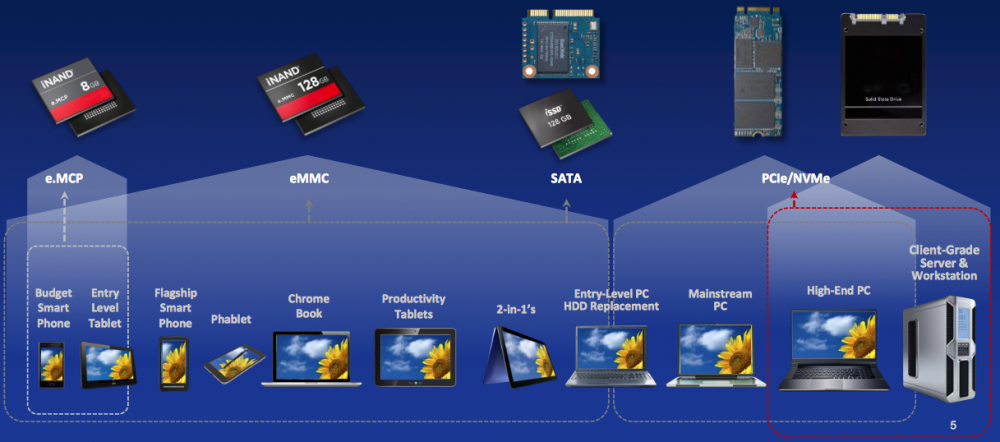PCIe/NVMe IN MOBILE DEVICES
ELAD BARAM – SENIOR DIRECTOR PRODUCT MANAGEMENT FOR CLIENT PLATFORMS SOLUTIONS, SANDISK CORPORATION
There is a convergence of client platforms, as we see smart client device segments blurring. Whether it be a budget smartphone, tablet, mainstream PC of client-grade server, computing platforms are becoming truly mobile.
The future of mobile storage is PCIe/NVMe, obviously due to the scalability, bandwidth, availability, compatibility, lower latency, simplicity and design.
This makes sense as PCIe/NVMe provides efficient data transfer paths, while utilizing little power and it minimizes the AP involvement in transactions. NVMe will support parallelism in platform, which will increase multitasking in mobile devices. It’s also easily supported as NVMe SSD is immediately enabled with it’s open source driver.
3D NAND COST AND TRANSITION TIMELINE
MARK WEBB – MKW VENTURES, LLC
At full productions, 32L wafer cost is currently 70% more expensive than 2D NAND, this is due to the drop in fabrication output per square foot and there is a requirement for new equipment. Yeilds are currently much lower for 3D NAND at less than 50% during the initial production. Wafer and die costs will start very high, but will drop over their lifetime with an increase in production efficiency and higher production yields.
Due to the high density, it is believed that 3D NAND will not be dominant in 2016 or 2017, mainly because approximately 20% of NAND goes to SSDs, which is the primary target of 3D NAND. However, 3D NAND will affect the market until such time as we can expect planar NAND to continue to decrease in price.
DRAM-LESS SSD FACILITATES HDD REPLACEMENT
STANLEY HUANG – DIRECTOR PRODUCT MARKETING, SILICON MOTION, INC.
Taking a look at the graph below, we can see the adoption rate from SATA 2 to PCIe.
When comparing DRAM-Less SSDs to DRAM SSDs, we see lower performance with longer latency and program fail handling, while still providing much better sequential read and write performance than HDD.
OEM manufacturers want to see the cost of SSDs reduced to around the price of $35-40 for a 128GB SSD. By producing a DRAM-Less drive, we see that price does decrease on average by 10% and in accordance with Moore’s Law, it should allow for twice the amount of NAND. Taking a look at the same graph, we can see a similar trend of adoption, but as we move from MLC to TLC NAND SATA drives to PCIe 3D TLC NAND, and also from SATA DRAM-Less to PCIe DRAM-Less.
Stay tuned for more FMS 2015 coverage here at The SSD Review!
 The SSD Review The Worlds Dedicated SSD Education and Review Resource |
The SSD Review The Worlds Dedicated SSD Education and Review Resource | 

